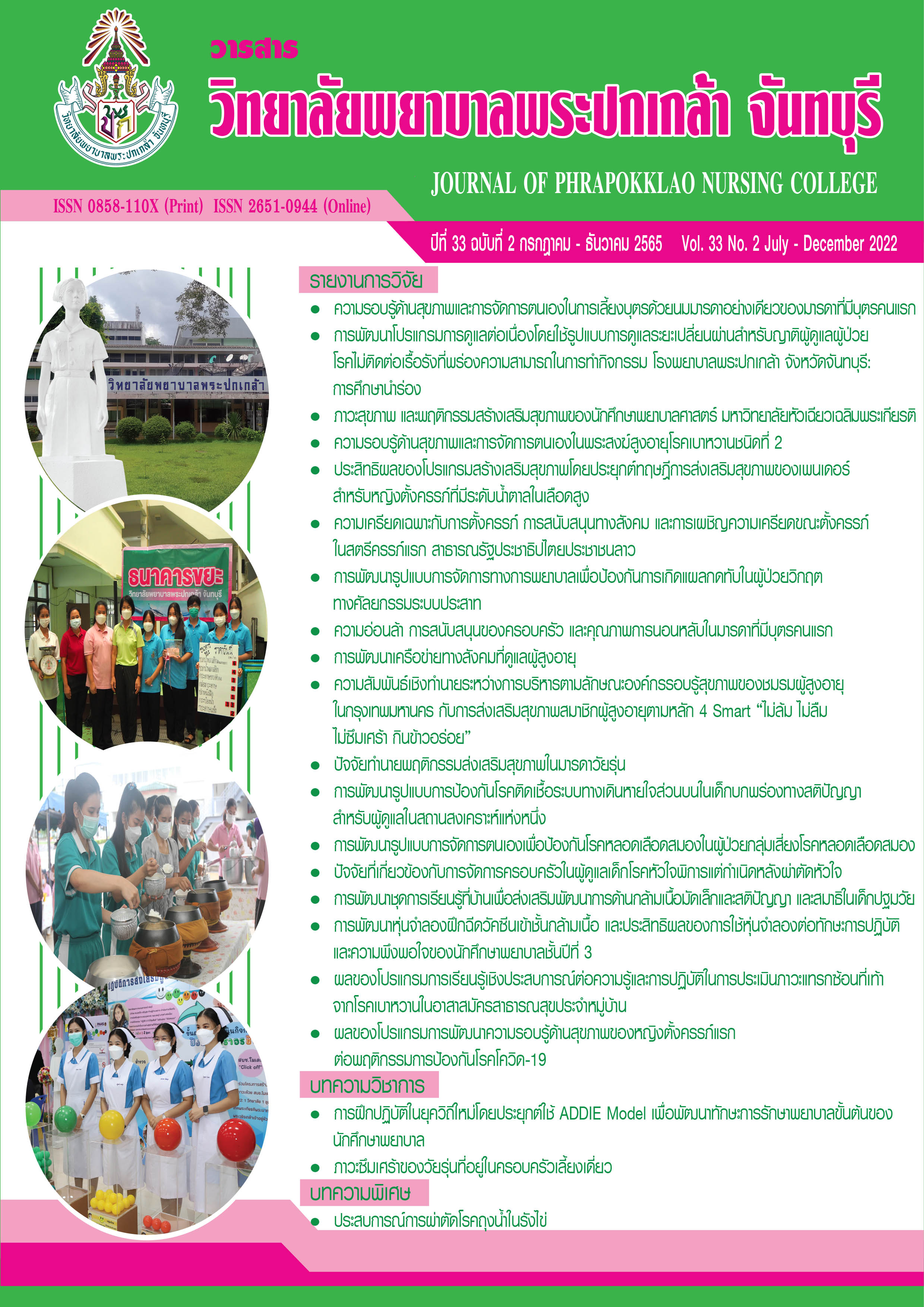Development of a Nursing Management Model for Preventing Pressure Ulcers among Neurosurgical Critical Patients
Keywords:
Nursing management model, Pressure ulcer, Neurosurgical critical patientAbstract
This research and development aimed to develop and study the effectiveness of a nursing management model for preventing pressure ulcers among neurosurgical critical patients, Mahasarakham Hospital. Four steps in the development of a model were: 1) situational analysis; 2) model development; 3) implementation to determine a model’s effectiveness with 120 neurosurgical critical patients and 18 registered nurses; and 4) model evaluation, improvement, and confirmation. The research instruments consisted of the pressure ulcer record form, the questions for a focused group discussion, the questionnaire of model’s structure, the nursing care observation checklist with reliability of 1, the questionnaire of nurses’ competency on pressure ulcer prevention with reliability of .82, and the questionnaire of nurses’ opinions on the developed model with reliability of .87. The implementation and data collection were conducted from October, 2020 to March, 2022. Data were analyzed using frequency, percentage, mean, standard deviation, Chi-square test, Mann-Whitney U Test, and content analysis.
The research results revealed that 1) the nursing management model for preventing pressure ulcers consisted of three elements as following: (1) inputs, including policy and improvement plan, structure, job description of head ward and nursing supervisor, nursing competency, and facilities; (2) process, P-PECS Framework for implementation of pressure ulcer prevention, including participation, patients center, evidence based practice, nursing competency enhancement, and nursing supervision; and (3) outcomes, including key performance indicators about structures, processes, and outcomes. 2) After implementing the model, the patients had statistical significance lower incidence of pressure ulcer than before implementing the model (p < .001). All nurses had practiced following the guideline and they had statistical significance perceived patient care competency to prevent pressure ulcers higher than before implementing the model (p < .001). 86.54% of the nurses highlighted that the model improvement was good at quality with a high satisfaction level of the model (M = 4.35, SD = .87).
This research suggests that other healthcare facilities should adopt this nursing management model to prevent pressure ulcers among neurosurgical critical patients.
References
กลุ่มงานการพยาบาลผู้ป่วยหนัก โรงพยาบาลมหาสารคาม. (2564). รายงานตัวชี้วัดประจำปี 2563 และการวิเคราะห์ผลการดำเนินงาน. มหาสารคาม: โรงพยาบาลมหาสารคาม.
กองการพยาบาล สำนักงานปลัดกระทรวงสาธารณสุข. (2562). แนวทางการจัดเก็บตัวชี้วัดการพัฒนาคุณภาพบริการพยาบาล ประจำปีงบประมาณ 2563. สืบค้นจาก https://skko.moph.go.th/dward/document_file/qa/common_form_upload_file/20191113141226_578732059.pdf
กิ่งกาญจน์ ทรัพย์เย็น, กนกทอง จาตุรงคโชค, และกฤตยา ตันติวรสกุล. (2562). การพัฒนารูปแบบการนิเทศทางการพยาบาลในคลินิกเพื่อป้องกันการเกิดแผลกดทับ โรงพยาบาลบ้านโป่ง. วารสารแพทย์เขต 4–5, 38(4), 300–317.
มณีนุช สุทธสนธิ์, และกาญจนา ปัญญาธร. (2562). ประสิทธิผลของการใช้แนวปฏิบัติการป้องกันการเกิดแผลกดทับในผู้ป่วยอาการหนัก โรงพยาบาลค่ายประจักษ์ศิลปาคม จังหวัดอุดรธานี. วารสารการพยาบาลและการดูแลสุขภาพ, 37(4), 80–89.
ศศิธร พิชัยพงศ์. (2557). การวิเคราะห์สถานการณ์การป้องกันการเกิดแผลกดทับในผู้ป่วยสูงอายุบาดเจ็บสมองที่ได้รับการผ่าตัด หอผู้ป่วยศัลยกรรมชาย โรงพยาบาลลำพูน. สืบค้นจาก http://cmuir.cmu.ac.th/bitstream/6653943832/39897/1/ABSTRACT.pdf
สถาบันรับรองคุณภาพสถานพยาบาล (องค์การมหาชน). (2561). เป้าหมายความปลอดภัยของผู้ป่วยของประเทศไทย พ.ศ. 2561 Patient safety goals: SIMPLE Thailand 2018. กรุงเทพฯ: เฟมัส แอนด์ ซัคเซ็สฟูล.
สังวาลย์ ธนะแก้ว, และศศิธร พิชัยพงศ์. (2557). การพัฒนาแนวทางปฏิบัติการป้องกันแผลกดทับในผู้ป่วยศัลยกรรมชาย โรงพยาบาลลำพูน. วารสารสาธารณสุขล้านนา, 10(3), 173–182.
สำนักการพยาบาล กรมการแพทย์. (2551). มาตรฐานการพยาบาลในโรงพยาบาล (ปรับปรุงครั้งที่ 2) (พิมพ์ครั้งที่ 3). กรุงเทพฯ: โรงพิมพ์องค์การสงเคราะห์ทหารผ่านศึก.
สำนักการพยาบาล กรมการแพทย์. (2554). การประกันคุณภาพการพยาบาล: การประเมินคุณภาพการบริการพยาบาลผู้ป่วยหนัก. กรุงเทพฯ: สามเจริญพาณิชย์ (กรุงเทพ).
สุชาดา นิลบรรพต, อัมพรพรรณ ธีรานุตร, และปณิตา ลิมปะวัฒนะ. (2562). ปัจจัยทำนายการเกิดแผลกดทับในผู้ป่วยวิกฤต. วารสารพยาบาลศาสตร์และสุขภาพ, 42(3), 1–10.
อุบลรัตน์ วิสุทธินันท์, และกฤตพัทธ์ ฝึกฝน. (2559). ผลการใช้แนวปฏิบัติการดูแลผู้ป่วยบาดเจ็บที่ศีรษะระดับปานกลางและรุนแรงต่อการเกิดแผลกดทับและภาวะปอดอักเสบที่สัมพันธ์กับการใช้เครื่องช่วยหายใจ. วารสารการพยาบาล การสาธารณสุข และการศึกษา, 17(3), 33–41.
Alderden, J., Rondinelli, J., Pepper, G., Cummins, M., & Whitney, J. (2017). Risk factors for pressure injuries among critical care patients: A systematic review. International Journal of Nursing Studies, 71, 97–114. doi:10.1016/j.ijnurstu.2017.03.012
Anderson, B. R. (2016). Improving health care by embracing Systems Theory. The Journal of Thoracic and Cardiovascular Surgery, 152(2), 593–594. doi:10.1016/j.jtcvs.2016.03.029
Dhandapani, M., Dhandapani, S., Agarwal, M., & Mahapatra, A. K. (2014). Pressure ulcer in patients with severe traumatic brain injury: Significant factors and association with neurological outcome. Journal of Clinical Nursing, 23(7–8), 1114–1119. doi:10.1111/jocn.12396
Donabedian, A. (2003). An introduction to quality assurance in health care. New York: Oxford University Press.
Edsberg, L. E., Black, J. M., Goldberg, M., McNichol, L., Moore, L., & Sieggreen, M. (2016). Revised National Pressure Ulcer Advisory Panel Pressure Injury Staging System: Revised Pressure Injury Staging System. Journal of Wound, Ostomy, and Continence Nursing, 43(6), 585–597. doi:10.1097/WON.0000000000000281
Guzman, J. L., McClanahan, R., & Vaughn, S. (2019). Development of guidelines for pressure ulcer prevention. Wounds Middle East, 6(1), 12–16. Retrieved from https://www.woundsinternational.com/uploads/resources/c40fc56577a0be24d26da79c1c18dc0f.pdf
Krupp, A. E., & Monfre, J. (2015). Pressure ulcers in the ICU patient: An update on prevention and treatment. Current Infectious Disease Reports, 17(3), 468. doi:10.1007/s11908-015-0468-7
Nassaji, M., Askari, Z., & Ghorbani, R. (2014). Cigarette smoking and risk of pressure ulcer in adult intensive care unit patients. International Journal of Nursing Practice, 20(4), 418–423. doi:10.1111/ijn.12141
Osis, S. L., & Diccini, S. (2020). Incidence and risk factors associated with pressure injury in patients with traumatic brain injury. International Journal of Nursing Practice, 26(3), e12821. doi:10.1111/ijn.12821
Tran, J. P., McLaughlin, J. M., Li, R. T., & Phillips, L. G. (2016). Prevention of pressure ulcers in the acute care setting: New innovations and technologies. Plastic and Reconstructive Surgery, 138(Suppl. 3), 232–240. doi:10.1097/PRS.0000000000002644
von Bertalanffy, L. (1969). General system theory: Foundations, development, applications (revised edition). New York: George Braziller.
Yoon, J. E., & Cho, O. H. (2022). Risk factors associated with pressure ulcers in patients with traumatic brain injury admitted to the intensive care unit. Clinical Nursing Research, 31(4), 648–655. doi:10.1177/10547738211050489
Downloads
Published
How to Cite
Issue
Section
License
Copyright (c) 2022 JOURNAL OF PHRAPOKKLAO NURSING COLLEGE

This work is licensed under a Creative Commons Attribution-NonCommercial-NoDerivatives 4.0 International License.
เนื้อความ ข้อมูล และรายการอ้างอิงที่ผู้เขียนใช้ในการเขียนบทความเพื่อลงตีพิมพ์ในวารสารวิทยาลัยพยาบาลพระปกเกล้า จันทบุรี ถือเป็นความคิดเห็นและความรับผิดชอบของผู้เขียน คณะผู้จัดทำวารสารไม่จำเป็นต้องเห็นพ้องด้วยหรือร่วมรับผิดชอบ
บทความที่ได้รับการลงตีพิมพ์ในวารสารวิทยาลัยพยาบาลพระปกเกล้า จันทบุรี ถือเป็นลิขสิทธิ์ของวารสารวิทยาลัยพยาบาลพระปกเกล้า จันทบุรี หากหน่วยงานหรือบุคคลใดต้องการนำส่วนหนึ่งหรือทั้งหมดของบทความไปเผยแพร่ต่อเพื่อวัตถุประสงค์ใด ๆ จะต้องได้รับอนุญาตจากบรรณาธิการวารสารก่อน



